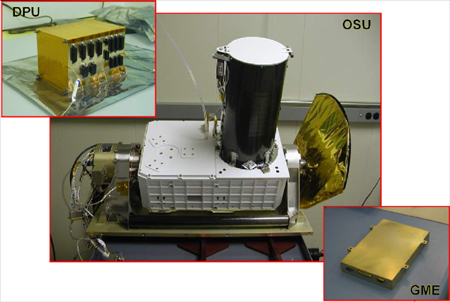Design
Overview
CRISM is an imaging spectrometer with a scannable field of view that can cover wavelengths from 0.362 to 3.92 microns (362 to 3920 nanometers) at 6.55 nanometers/channel. This means that CRISM can observe in both the visible range (0.38 – 0.70 microns) and shorter wavelengths within the infrared wavelength range (the full infrared wavelength range is 0.7- 1000 microns). Being able to detect light in these wavelength ranges enables the CRISM team to identify a broad range of minerals on the Martian surface.
At visible wavelengths, the way light is reflected is strongly influenced by iron in minerals - for example rust, or iron oxide, appears red. At infrared wavelengths, CRISM can "see" features due to sulfate, carbonate, hydroxyl, and water incorporated into mineral crystals, plus it has greater sensitivity to the kinds of minerals containing iron. None of this is possible at visible wavelengths. It is the coverage of infrared wavelengths that gives CRISM most of its capabilities to map composition of Mars' surface.
The CRISM instrument consists of:
- The Optical Sensor Unit (OSU), which includes the optics, a gimbal to remove smear due to spacecraft motion, two detectors for visible and infrared images, cryocoolers to cool the infrared detectors, radiators to keep the instrument cold, and electronics.
- The Gimbal Motor Electronics (GME), which commands and powers the gimbal and analyzes data from its angular position encoder in a feedback loop
- The Data Processing Unit (DPU), which accepts and processes commands from the spacecraft and data from the OSU to communicate it to the spacecraft

